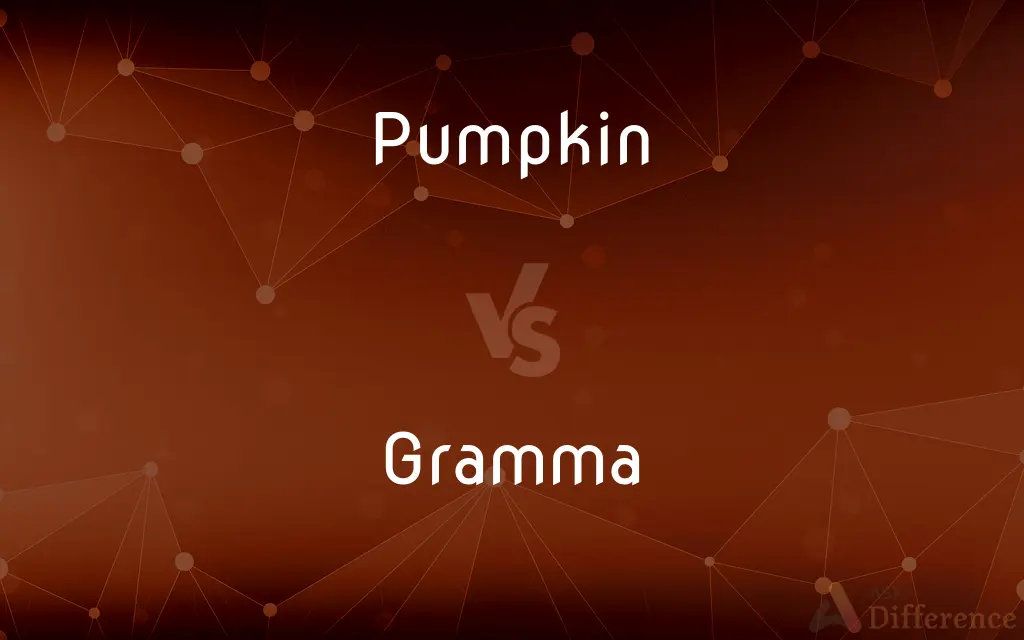Pumpkin vs. Gramma — What's the Difference?
Edited by Tayyaba Rehman — By Fiza Rafique — Updated on March 9, 2024
Both are types of squash, but pumpkins are typically round and orange, used for carving and pies, while gramma squash is sweeter, denser, and used in similar culinary ways.

Difference Between Pumpkin and Gramma
Table of Contents
ADVERTISEMENT
Key Differences
Pumpkins, known for their vibrant orange color and association with fall festivities, are a popular squash variety often used in decorations, carving, and culinary dishes like pies and soups. They have a mildly sweet flavor and a somewhat fibrous texture. On the other hand, gramma squash, less known outside of certain regions like Australia, is a type of winter squash that resembles a pumpkin but has a sweeter, denser flesh. It is often used in similar culinary contexts as pumpkin, including baking and soups, but its sweeter taste makes it a preferred choice for desserts and sweet dishes.
While pumpkins are widely recognized for their iconic role in autumn celebrations, gramma squash is more of a culinary favorite for those who prefer a sweeter and denser squash variety. Both can be baked, roasted, or turned into soups, but the choice between the two often comes down to the desired sweetness and texture in the final dish.
In terms of nutritional content, both pumpkins and gramma squash are rich in vitamins, minerals, and fiber, making them a healthy addition to any diet. However, gramma squash may have a slightly higher sugar content due to its sweeter taste, which should be considered when preparing meals for those with specific dietary needs.
While both pumpkins and gramma squash can be grown in home gardens, pumpkins are often easier to find in stores due to their widespread popularity, especially in the fall. Gramma squash, being less common, might require a visit to specialty stores or farmers' markets, particularly in regions where it is not a traditional crop.
Comparison Chart
Shape
Typically round and slightly ribbed
Varies, often more elongated and less uniform
ADVERTISEMENT
Color
Bright orange
Deep orange to greenish
Texture
Mildly sweet, somewhat fibrous
Sweeter, denser
Culinary Uses
Pies, soups, decorations, carving
Baking, soups, sweet dishes
Cultural Significance
Associated with Halloween and Thanksgiving
Less widely celebrated, regional
Compare with Definitions
Pumpkin
A large round orange squash with a thick shell.
We carved a face into the pumpkin for Halloween.
Gramma
A type of winter squash with sweet, dense flesh.
She used gramma squash in her pie for a sweeter taste.
Pumpkin
The flesh of this squash when cooked.
She made a delicious pumpkin pie for dessert.
Gramma
A culinary choice for sweeter dishes.
For a richer dessert, they chose gramma squash over pumpkin.
Pumpkin
A plant producing this fruit.
The pumpkin vines spread across the garden.
Gramma
The fruit of a gramma plant, often used in cooking.
The gramma squash was ripe and ready to be picked.
Pumpkin
A term of endearment.
Goodnight, pumpkin, she said to her child.
Gramma
A plant that produces gramma fruits.
The gramma plants thrived in the warm climate.
Pumpkin
A bright orange color reminiscent of the squash.
She wore a pumpkin-colored dress to the fall festival.
Gramma
A term used in some regions to refer to this specific squash.
Could you pass me the gramma? she asked while cooking.
Pumpkin
A pumpkin is a cultivar of winter squash that is round with smooth, slightly ribbed skin, and is most often deep yellow to orange in coloration. The thick shell contains the seeds and pulp.
Gramma
A grandmother.
Pumpkin
A round, often large squash with coarse, strongly flavored yellow to orange flesh, numerous seeds, and a moderately hard, usually orange rind.
Gramma
Variant of grama.
Pumpkin
Any of several plants producing these fruits, especially varieties of the species Cucurbita pepo, and also varieties of C. maxima and C. moschata.
Gramma
Any of various grasses of the genus Bouteloua of western North America and South America, forming dense tufts or mats and often used as pasturage.
Pumpkin
A moderate to strong orange.
Gramma
A pasture grass of the plains of South America and western North America; same as grama grass, which see.
Pumpkin
A domesticated plant, in species Cucurbita pepo, similar in growth pattern, foliage, flower, and fruit to the squash or melon.
Gramma
Pasture grass of plains of South America and western North America
Pumpkin
The round yellow or orange fruit of this plant.
Pumpkin
(uncountable) The color of the fruit of the pumpkin plant.
Pumpkin
(Australia) Any of a number of cultivars from the genus Cucurbita; known in the US as winter squash.
Pumpkin
(US) A term of endearment for someone small and cute.
Pumpkin
A well-known trailing plant (Cucurbita pepo) and its fruit, - used for cooking and for feeding stock; a pompion.
Pumpkin
A coarse vine widely cultivated for its non-keeping large pulpy round orange fruit with firm orange skin and numerous seeds; subspecies of Cucurbita pepo include the summer squashes and a few autumn squashes
Pumpkin
Usually large pulpy deep-yellow round fruit of the squash family maturing in late summer or early autumn
Common Curiosities
Can both pumpkins and gramma squash be used for carving?
Pumpkins are traditionally used for carving due to their size and shape, while gramma squash is less commonly used for this purpose.
Can gramma squash be used as a substitute for pumpkin in recipes?
Yes, gramma squash can often substitute for pumpkin, especially in sweet dishes due to its denser and sweeter flesh.
What is the main difference between pumpkin and gramma squash?
The main difference is in their taste and texture; pumpkins are milder and more fibrous, while gramma squash is sweeter and denser.
How do you store pumpkin and gramma squash to extend their shelf life?
Both should be stored in a cool, dry place; pumpkins have a longer shelf life, while gramma squash should be used more quickly due to its higher moisture content.
Is gramma squash available year-round?
Like most squash, gramma squash is typically harvested in late summer through fall, but stored properly, it can be available into the winter.
How do you prepare pumpkin and gramma squash for cooking?
Both need to be washed, cut open, seeds removed, and then can be roasted, baked, or boiled depending on the recipe.
Is there a significant price difference between pumpkin and gramma squash?
The price can vary based on region and availability; pumpkins may be more affordably priced, especially in season, due to their popularity.
Are pumpkins and gramma squash nutritionally similar?
Both are nutritious, offering vitamins, minerals, and fiber, though gramma squash may have slightly more sugar.
Can both pumpkin and gramma squash be grown in a home garden?
Yes, both can be grown in home gardens, but they require space to spread and a warm growing season.
Are there any particular dishes that are best suited for gramma squash over pumpkin?
Gramma squash is particularly well-suited for sweet dishes like pies and custards due to its sweeter flavor.
Are pumpkin and gramma squash suitable for a low-carb diet?
Both contain carbohydrates, with gramma squash being slightly higher in sugars, so they should be consumed in moderation on a low-carb diet.
Can pumpkin and gramma squash be eaten raw?
While technically edible raw, they are usually cooked to soften their flesh and enhance their flavors.
Can pumpkin seeds and gramma squash seeds be eaten?
Yes, the seeds of both can be cleaned, roasted, and eaten as a nutritious snack.
What are the best climates for growing pumpkin and gramma squash?
Both thrive in warm climates with well-draining soil and plenty of sunshine, but they have different water and space requirements.
How can you tell when pumpkin and gramma squash are ripe and ready to be harvested?
They are ready when the skin is hard and the connecting vine starts to wither; the color also deepens to a rich hue.
Share Your Discovery

Previous Comparison
Hold vs. Castle
Next Comparison
Herby vs. HerebyAuthor Spotlight
Written by
Fiza RafiqueFiza Rafique is a skilled content writer at AskDifference.com, where she meticulously refines and enhances written pieces. Drawing from her vast editorial expertise, Fiza ensures clarity, accuracy, and precision in every article. Passionate about language, she continually seeks to elevate the quality of content for readers worldwide.
Edited by
Tayyaba RehmanTayyaba Rehman is a distinguished writer, currently serving as a primary contributor to askdifference.com. As a researcher in semantics and etymology, Tayyaba's passion for the complexity of languages and their distinctions has found a perfect home on the platform. Tayyaba delves into the intricacies of language, distinguishing between commonly confused words and phrases, thereby providing clarity for readers worldwide.















































